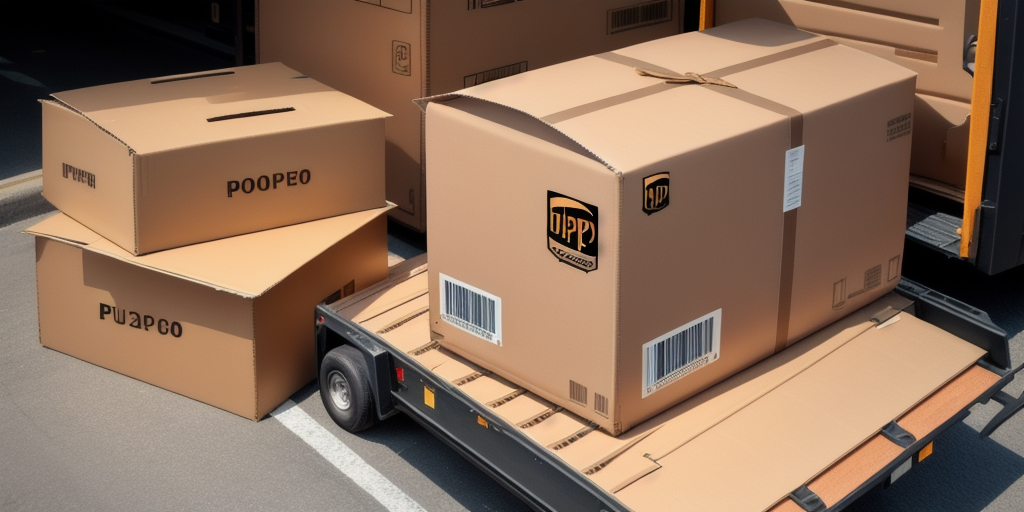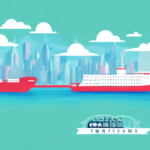Understanding UPS Shipping Rates for FTL Shipments
If you're involved in logistics and transportation, you've likely encountered the term FTL, or Full Truckload. This shipping service transports goods in a single, uninterrupted shipment between one origin and one destination. FTL shipments can range from a few thousand pounds to full truckloads of goods, catering to businesses that need efficient and reliable transportation solutions.
What is FTL Shipping and How is it Different from LTL Shipping?
Both FTL and LTL (Less than Truckload) shipping involve transporting goods via truck, but they differ in several key ways:
- Shipment Volume: FTL uses an entire truck for a single shipment, making it ideal for large volumes, whereas LTL consolidates goods from multiple shippers into one truck.
- Cost: FTL tends to be more expensive due to exclusive truck use, but it can be more cost-effective per unit for large shipments. LTL is generally cheaper for smaller shipments as you only pay for the space you use.
- Delivery Speed: FTL offers faster and more direct delivery since the shipment doesn't mix with others, while LTL may involve multiple stops and longer transit times.
For businesses with significant shipment volumes or strict delivery deadlines, FTL is often the preferred choice. Conversely, LTL is suitable for smaller businesses or less time-sensitive deliveries.
Factors that Affect UPS Shipping Rates for FTL Shipments
When calculating the cost of FTL shipments with UPS, several factors come into play:
- Weight of the Shipment: Heavier shipments incur higher costs.
- Distance: The distance between the origin and destination significantly impacts the rate.
- Pickup and Delivery Locations: Urban versus rural locations can affect pricing due to varying logistics costs.
- Mode of Transportation: Choices between standard, expedited, or specialized transport modes can alter rates.
- Type of Goods: Hazardous materials or perishable goods may require special handling, increasing costs.
Additionally, the time of year influences UPS shipping rates. Peak seasons, such as the holiday period, typically see higher rates due to increased demand. The level of service required, like expedited shipping or special handling, also affects the overall cost.
UPS offers various discounts and promotions based on factors like shipment volume, frequency, and the nature of the goods being shipped. Exploring these discounts can lead to substantial savings on UPS shipping rates for FTL shipments.
For more detailed information on pricing factors, refer to UPS's official shipping rate factors.
How to Calculate UPS Shipping Rates for FTL Shipments
Calculating UPS shipping rates for FTL shipments involves considering the factors mentioned above. UPS provides a user-friendly online calculator where you can input details such as origin, destination, weight, and transportation mode to get an estimated cost.
Keep in mind that shipping rates can vary based on seasonal demand. Planning your shipments during off-peak times can result in significant savings. Additionally, reaching out to a UPS representative for a customized quote can provide more accurate pricing tailored to your specific needs.
For comprehensive guidance on calculating shipping costs, refer to UPS's official guide.
Tips to Save Money on UPS Shipping Rates for FTL Shipments
Managing shipping costs is crucial for maintaining profitability. Here are some strategies to save on UPS shipping rates for FTL shipments:
- Plan Ahead: Avoid last-minute shipments to prevent rush fees.
- Consolidate Shipments: Combine multiple smaller shipments into one larger FTL shipment to benefit from volume discounts.
- Negotiate Rates: Engage with UPS or third-party logistics providers to negotiate better rates based on your shipping volume and needs.
- Optimize Packaging: Use appropriately sized packaging to reduce weight and dimensions, leading to lower costs.
- Use Eco-Friendly Materials: Not only environmentally responsible, but some materials can also be more cost-effective.
Staying informed about UPS's pricing changes and leveraging their online tools, such as the shipping calculator and shipping guides, can further aid in making cost-effective decisions.
Understanding the Role of Freight Class in UPS Shipping Rates for FTL Shipments
The classification of goods plays a vital role in determining shipping rates. UPS utilizes the National Motor Freight Classification (NMFC) system to categorize goods based on density, value, and handling characteristics. There are 18 freight classes, ranging from Class 50 to Class 500:
- Class 50: Lowest shipping rates, applicable to goods with high density and easy handling.
- Class 500: Highest shipping rates, applicable to goods that are light, valuable, or difficult to handle.
Accurately classifying your goods ensures you are charged appropriately and helps avoid overpaying. For instance, Class 50 goods like lubricants benefit from lower rates, while Class 500 items such as light electronics incur higher costs.
Other factors influencing shipping rates include the weight and dimensions of the shipment, origin and destination, and any additional services like liftgate delivery or inside pickup. Properly understanding and applying freight classes can lead to optimized shipping costs and efficient transportation management.
For more information on freight classification, visit the Freight Classification Guide.
Common Mistakes that Can Lead to Higher UPS Shipping Rates for FTL Shipments
Avoiding common pitfalls can help maintain cost-efficiency in your FTL shipments. Here are some frequent mistakes that result in higher UPS shipping rates:
- Poor Packaging: Inadequately packaged goods can lead to damage, delays, and additional fees.
- Incorrect Weight or Value Declaration: Misdeclaring shipment weight or value may result in unexpected costs or legal issues.
- Improper Labeling: Incorrect labels can cause delays or loss of shipments, leading to additional charges.
- Inaccurate Documentation: Especially for international shipments, incomplete or incorrect customs documentation can incur fines and delays.
By ensuring proper packaging, accurate declarations, correct labeling, and complete documentation, you can avoid these costly errors and streamline your shipping process.
How to Negotiate Better UPS Shipping Rates for FTL Shipments
Negotiating better rates with UPS requires a strategic approach. Here are some tips to secure more favorable UPS shipping rates for FTL shipments:
- Build a Relationship: Regularly communicating with your UPS representative can open doors for customized rate agreements.
- Leverage Shipping Volume: Higher shipping volumes can provide leverage for discounts and better rates.
- Consolidate Shipments: Combining multiple shipments reduces the number of trips, which can result in volume discounts.
- Use Third-Party Logistics Providers: These providers often have established relationships with carriers and can negotiate better rates on your behalf.
- Review Invoices Regularly: Spotting discrepancies can ensure you're not overcharged and can provide grounds for negotiation.
Additionally, staying informed about market rates and being flexible with shipping schedules can enhance your negotiating power. Consistently reviewing and adjusting your shipping strategies in collaboration with UPS can lead to sustained cost savings.
The Benefits of Using a Third-Party Logistics Provider for UPS Shipping Rates for FTL Shipments
Partnering with a third-party logistics (3PL) provider can offer numerous advantages for managing UPS shipping rates for FTL shipments:
- Access to Better Rates: 3PLs often negotiate volume discounts, providing more competitive rates than individual shippers can achieve.
- Improved Tracking and Visibility: Enhanced tracking systems offer real-time updates and better shipment management.
- Increased Flexibility: A broader range of shipping options allows for more tailored solutions to meet specific needs.
- Operational Efficiency: 3PLs handle logistics tasks such as paperwork, coordination, and compliance, saving you time and resources.
- Consolidation of Shipments: Combining multiple shipments reduces costs and environmental impact.
Additionally, 3PLs bring expertise and industry knowledge, helping you navigate complex shipping regulations and optimize your supply chain. By leveraging the services of a reputable 3PL, businesses can achieve greater efficiency and cost savings in their FTL shipping operations.
Learn more about the benefits of 3PLs in our detailed guide.
How Technology is Changing the Landscape of UPS Shipping Rates for FTL Shipments
Technological advancements are revolutionizing FTL shipments, influencing UPS shipping rates in several ways:
- Route Optimization: Advanced algorithms and GPS technology enable UPS to identify the most efficient routes, reducing fuel consumption and operational costs.
- Automation: Robotics and artificial intelligence streamline operations like sorting and loading, enhancing efficiency and lowering labor costs.
- Real-Time Tracking: Enhanced tracking systems provide better visibility into shipments, allowing for timely adjustments and improved service reliability.
- Electric and Autonomous Vehicles: Investment in sustainable transportation methods reduces environmental impact and can lead to long-term cost savings.
These technologies not only improve operational efficiency but also contribute to more competitive shipping rates. For example, optimized routes and reduced fuel consumption directly translate to lower transportation costs.
Furthermore, the integration of Internet of Things (IoT) devices in logistics allows for better monitoring of shipment conditions, ensuring goods are transported safely and efficiently. As technology continues to evolve, it will play an increasingly pivotal role in shaping the future of FTL shipping and UPS shipping rates.
Stay updated with the latest technological trends in logistics by visiting our technology trends page.




















